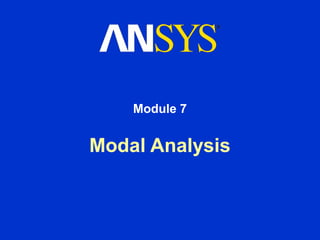2 07 modal
- 2. Octo ber 30, 2001 Inven INTRODUCTIONTOANSYS6.0-INTRODUCTIONTOANSYS6.0- Part2Part2 Training Manual 7. Modal Analysis • Modal analysis is used to determine a structure’s vibration characteristics — natural frequencies and mode shapes. • It is the most fundamental of all dynamic analysis types and is generally the starting point for other, more detailed dynamic analyses. • In this chapter, we will describe how to do a basic modal analysis via the following topics: A. Procedure B. Workshop For details, refer to your Structural Analysis Guide or Dynamics Training Manual.
- 3. Octo ber 30, 2001 Inven INTRODUCTIONTOANSYS6.0-INTRODUCTIONTOANSYS6.0- Part2Part2 Training Manual Modal Analysis A. Procedure • The steps to do a modal analysis are as follows: – Preprocessing • Geometry • Meshing – Solution • Analysis Type and Options • Loading • Solve – Postprocessing • Review results
- 4. Octo ber 30, 2001 Inven INTRODUCTIONTOANSYS6.0-INTRODUCTIONTOANSYS6.0- Part2Part2 Training Manual Modal Analysis ...Procedure Geometry & Meshing • Same considerations as a static analysis: – Include as many details as necessary to sufficiently represent model geometry. – A fine mesh will be needed to resolve complex mode shapes. • Both Young’s modulus and density are required. – Specify mass density instead of weight density when using British units. • weight density (lb/in3 ) ÷ g (in/sec2 ) = mass density (lb-sec2 /in4 ) • For example, density of steel = 0.283/386 = 7.3E-04 lb-sec2 /in4 • Linear elements and material properties only. Nonlinearities are ignored.
- 5. Octo ber 30, 2001 Inven INTRODUCTIONTOANSYS6.0-INTRODUCTIONTOANSYS6.0- Part2Part2 Training Manual Modal Analysis ...Procedure Analysis Type • The analysis type is modal. – Solution > -Analysis Type- New Analysis – Or issue ANTYPE,MODAL
- 6. Octo ber 30, 2001 Inven INTRODUCTIONTOANSYS6.0-INTRODUCTIONTOANSYS6.0- Part2Part2 Training Manual Modal Analysis ...Procedure Analysis Options • Mode extraction options – MODOPT command or Solution > Analysis Options... – Method: Block Lanczos is generally recommended. – Number of modes: Specify the number of modes you want to extract. • Mode expansion options – MXPAND command or Solution > Analysis Options... – Expanding modes allows you to view them in the postprocessor. – Number of modes is usually the same as the number extracted. • Prestress effects – PSTRES command or Solution > Analysis Options... – calculate mode shapes of a prestressed structure, such as a spinning turbine blade. Default settings are usually sufficient
- 7. Octo ber 30, 2001 Inven INTRODUCTIONTOANSYS6.0-INTRODUCTIONTOANSYS6.0- Part2Part2 Training Manual Modal Analysis ...Procedure Loading & Solve • The only “loads” valid in a modal analysis are displacement constraints: – Solution > -Loads- Apply > Displacement > – Or use the D family of commands: D, DK, DL, DA, etc. • If you don’t specify constraints, ANSYS will calculate rigid body modes (zero frequency). • After all constraints have been specified, obtain the solution: – First save the database (SAVE command or Toolbar > SAVE_DB). – Then issue SOLVE (or Solution > -Solve- Current LS).
- 8. Octo ber 30, 2001 Inven INTRODUCTIONTOANSYS6.0-INTRODUCTIONTOANSYS6.0- Part2Part2 Training Manual Modal Analysis ...Procedure Review Results • POST1 (the general postprocessor) is used to review modal analysis results. • Typically, the first step is to list the natural frequencies: – General Postproc > Results Summary – Or issue SET,LIST – Note that each mode is stored in a separate substep.
- 9. Octo ber 30, 2001 Inven INTRODUCTIONTOANSYS6.0-INTRODUCTIONTOANSYS6.0- Part2Part2 Training Manual Modal Analysis ...Procedure • To plot a mode shape: – First read results for that substep • General Postproc > Results Summary... • Or use the SET command – Then plot the deformed shape • General Postproc > Plot Results > Deformed Shape • Or use the PLDISP command
- 10. Octo ber 30, 2001 Inven INTRODUCTIONTOANSYS6.0-INTRODUCTIONTOANSYS6.0- Part2Part2 Training Manual Modal Analysis ...Procedure • You can also animate mode shapes: – Utility Menu > PlotCtrls > Animate > Mode Shape – Or use the ANMODE command • Another option is to plot contours stresses and strains. Note, however, that displacement and stress values are simply relative numbers and have no real meaning.
- 11. Octo ber 30, 2001 Inven INTRODUCTIONTOANSYS6.0-INTRODUCTIONTOANSYS6.0- Part2Part2 Training Manual Modal Analysis B. Workshop • This workshop consists of the following problem: W6. U-Bracket Please refer to your Workshop Supplement for instructions.











